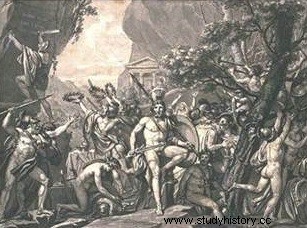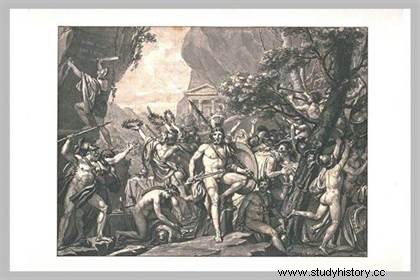 Leonidas at Thermopylae is a small painting (about twenty by twenty eight centimeters) finished in 1814 by the painter David and exhibited at the Louvre Museum. It celebrates a great battle which was the scene of the heroic death of Leonidas I and his 1,400 men, including 300 Spartans, in their attempt to repel the Persian invasion in 480 BC. Characteristic of the new wave of neoclassicism, in opposition to the Rococo style, this painting symbolizes the "beautiful ideal", thanks to the nude of the character in the foreground, as were represented by the statues of Greek, Roman and Antiquity. Egyptian. The “beautiful ideal” also pays homage to the courage and patriotism of the King of Sparta.
Leonidas at Thermopylae is a small painting (about twenty by twenty eight centimeters) finished in 1814 by the painter David and exhibited at the Louvre Museum. It celebrates a great battle which was the scene of the heroic death of Leonidas I and his 1,400 men, including 300 Spartans, in their attempt to repel the Persian invasion in 480 BC. Characteristic of the new wave of neoclassicism, in opposition to the Rococo style, this painting symbolizes the "beautiful ideal", thanks to the nude of the character in the foreground, as were represented by the statues of Greek, Roman and Antiquity. Egyptian. The “beautiful ideal” also pays homage to the courage and patriotism of the King of Sparta.
Leonidas at Thermopylae
Leonidas I, King of Sparta (c. 490-480 BC), achieved immortal glory for having heroically defended the defile of Thermopylae, the gate of Greece, against the Persian army of Xerxes I in 480 BC. At the head of a force inferior to that of his assailants, Leonidas contained the Persian invasion for two days, sufficient time to allow the Greek fleet to double Cape Artemision. A Thessalian named Ephialtes betrays Leonidas by showing Xerxes another path through the mountain.
Learning that he was about to be taken in the rear, Leonidas sent most of his troops back for cover and remained with some 300 Spartans, some Thespians and Thebans who refused to leave. Leonidas and his men put up fierce resistance to the Persians and caused them heavy casualties before dying. The Battle of Thermopylae will be recounted by Herodotus in his History .
David's painting
 The painter Jacques Louis David, relative of François Boucher, met Joseph Marie Vien, precursor of the return of the painting of History, inspired by ancient art, in reaction to Rococo. Under his leadership, David made the first sketches of this future painting in 1799, which was intended for an amateur, Count Sommariva. In this first drawing, King Leonidas was only shown from the side, with a huge rock in the back. The painter spent almost fifteen years creating this painting, until its completion in October 1814, the year in which Napoleon abdicated for the first time. It was acquired by the Louvre in 1826 and the drawing can be seen today at the Musée Fabre in Montpellier.
The painter Jacques Louis David, relative of François Boucher, met Joseph Marie Vien, precursor of the return of the painting of History, inspired by ancient art, in reaction to Rococo. Under his leadership, David made the first sketches of this future painting in 1799, which was intended for an amateur, Count Sommariva. In this first drawing, King Leonidas was only shown from the side, with a huge rock in the back. The painter spent almost fifteen years creating this painting, until its completion in October 1814, the year in which Napoleon abdicated for the first time. It was acquired by the Louvre in 1826 and the drawing can be seen today at the Musée Fabre in Montpellier.
This painting shows the sacrifice of Leonidas, King of Sparta and three hundred warriors of his personal guard (and not other soldiers, because according to religious custom it is forbidden to struggle at this time of year). They were massacred in the face of hundreds of thousands of Persian soldiers who invaded northern Greece, in the parade of Thermopylae in 480 BC. AD
Knowing that they were going to die, the soldiers have different opinions:some want to abandon their post, others stay to fight. Leonidas sends them away to spare them, and so stays to save the passage and Greece. By sacrificing himself, he becomes famous and passes on to posterity with all the glory possible. Leonidas is represented naked, like Greek statues. On the left, a soldier carves in stone the famous phrase "Passing by, go tell Sparta that three hundred heroes died for her ". It is a military defeat, but a moral victory, the emblem of Greek resistance against the invader, the symbol of patriotism.
To go further
- Jacques-Louis David:1748-1825, by Antoine Schnapper and Arlette Serullaz. RNM, 1992.
- The True Story of Sparta and the Battle of Thermopylae The True Story of Sparta and the Battle of Thermopylae, by Jean Malye. Beautiful Letters, 2007.
